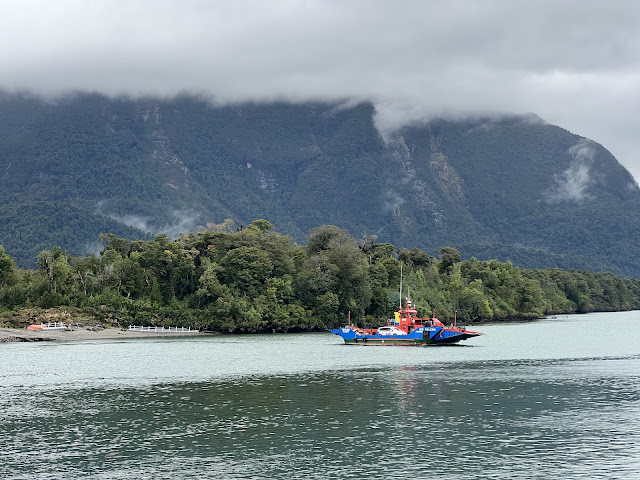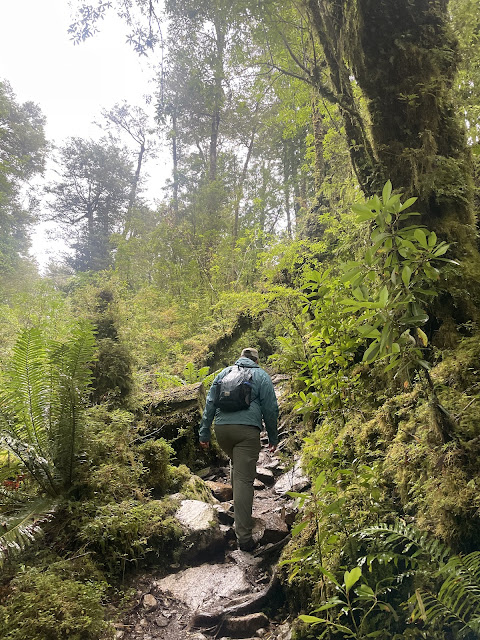I think it’s worth it forewarning that this post will be quite long for several reasons. For one, our time exploring the southern highway was absolutely the coolest thing we’ve ever done. Not only were the three weeks packed with adventurous activities, it was also the way in which we lived that was so memorable and life changing. We had to shift our expectations, our way of traveling, and because of the remoteness it was impossible to plan ahead - with the exception of the ferries. We had to take life day-by-day and adapt our every move. We did have the added bonus of having a car which is a huge help. We were able to pick up hitchhikers and make new friends. We cherished our rental car and grew very fond of it, after all it was our home for a while. On the road when not conversing with fellow travelers, we listened to podcasts and tons of music. After the three weeks we adjusted so well to our spontaneous and adaptive lifestyle that were deeply sadden to leave those three weeks behind.
The moments in Carretera Austral rekindled my passion for conservation and in a way came full circle on why I wanted to pursue an environmental career. Each day we were dowsed with adrenaline, incredible views, gratitude, and inspiration. To best illustrate our experience I am highlighting our time in Carretera Austral by sections from north to south. Even though I’m only sharing stories from our stops, the time on the road was an experience on its own. On the road we witnessed The Patagonian way of life from the Gauchos herding sheep and cattle, foreign cyclists pushing their endurance, remote farms, incredible views, a unique sense of the remoteness. Even the simple bridges and ferry crossings felt special.
Ferry Crossing to Official Route 7 - Carretera Austral
After a few days in the Lake District we headed south for the first official day of Carretera Austral on Valentine’s Day — romantic I know. To enter the official route we had to take three ferries to cross the Gulf of Acund which separates the Lake District from the Aysén Region (Chilean Patagonian). We had to reserve two of the ferries weeks in advance because of limited space. I share this because our first day had a rocky start. I mixed up our timing between the first and second ferries and about half way to the first ferry we realized the it was set to depart within minutes and we were still an hour away. At that point our hopes were gutted. Any attempts of calling the ferry company ended without anyone picking up. The next available slot was in four days. With hopes shattered we resigned to camp by the port in hopes of a space opening up in the next ferry. To our glee and miraculous surprise, when we arrived, we saw a long line of cars and learned that the ferry was delayed by several hours and we could board after all! The amount of relief, gratitude, and excitement was a blessing and sign that we were meant to do the trip. We definitely received help from something greater than us, and the start of an eventful three weeks with joyous gratitude. Because of the ferry’s delay we arrived to Caleta Gonzalo, our unplanned first night, at 1:00am. We slept in our car and waited til morning to visit the first park, Pumalin National Park.
Pumalin National Park
Pumalin National Park is a private park formally owned by conservationist, deep ecologist, and philanthropist Douglas Tompkins and now managed by CONAF. The free-entry park is one of the most thoughtfully designed and accessible ones we’ve ever visited - it’s a gem. The interpretation center is run by courteous and knowledgeable staff. On their advice we camped on the upper Ventisquero (Glacier) Campground. To get there we had to park our car in a lower campground and hike a steep hill with our gear. It was bittersweet to don our backpacking gear for the first time since Torres Del Paine - comforting, yet heavy. The designated campsite centers on views of The Ventisquero Amarillo (hanging glacier) which sits on the volcano Michimahuida. After pinching ourselves to reality from such beauty we enjoyed a peaceful evening surrounded by nature. The next morning we hiked the 20 km trail see the glacier up close. With somewhat conditioned bodies, the hike wasn’t that intense and it was lovely to explore the lush ecosystem and the admire the geologic features up close.
Futaleufú
After two restful days in Pumalin National Park, we decided to take a detour from the main highway to visit Futaleafú and try some world-class rafting. As we approached the town, we were awestruck by the deep aqua colors glacier-fed Futaleafú river, and knew we were up for something unique. Rafting the river was unlike anything we ever experienced. For some context, The Futaleafú is considered to be one of the top-five rivers for rafting in the world. The day-trip we chose contained five class V rapids and has famously been described as experiencing all the rapids from the Grand Canyons in one day. This was confirmed by a guide we met, who is from Colorado and has rafted both rivers. The rapids were massive and our favorite was one called the Terminator - it was all so exhilarating to witness. The day trip was the highlight of our whole time in Southern Chile. It’s difficult to beat crystal clear water, adrenaline, massive rapids, and beautiful canyon views.
Cerro Castillo
The next stop on our list was Queulat National Park to see another hanging glacier, sadly we passed the park on a Monday, the only day the park is closed. We shifted our plans and headed south to Cerro Castillo National Park. That night we stayed in the only campground which quickly became crowded. Despite our efforts to camp away from crowds, a couple decided to camp right next to us and kept us up most of the night. By morning, I was grouchy, tired and not in the mood to hike. We took a chill day and explored other sites nearby — el Salto and Puerto Ibañez. The second night on camp was better and after a restful sleep, we headed to Cerro Castillo trailhead. We got to the top in record time (third group to the top) and enjoyed the views of the beautiful mountain and glacier in solitude. It was an incredible hike with views of the valley below and of the castle-like mountaintop. The valley reminded us of how Estes Park was 100 years ago without infrastructure. By that point our hiking legs were quite strong and felt pleased with the challenge of completing the hike in record time.
Rio Tranquilo
After the hike we ventured even further south to the most talked about section of the highway, Rio Tranquilo and Lago General Carrera, more accurately known as Chelenko - its indigenous name. The lake is a turquoise blue and the largest lake in Chile, second largest in South America. This area is packed with eco-tourism and mindful recreational activities. We spent four days in the area to ice hike the Exploradores Glacier, visit San Rafael Glacier on the northern ice-field, and kayaked the Chelenko lake to marble caves. Each activity brought a new lesson and new appreciation for nature.
Our hike to Exploradores Glacier brought us up close to the anatomy of a glacier and ventured inside glacial caves. Paul even caught glimpse of a extremophile insect, the ice dragon, which is solely dependent on glacial ecosystems that are becoming increasingly rare. As we hiked on the glacier several condors flew by giving us a special Patagonian blessing.
On the second day we visited the San Rafael Glacier, a calving glacier with close-up views of icebergs and floating ice. Even the road to San Rafael National Park had more glaciers than I could count - truly breathtaking. To access the area we had to travel by car then by boat which went through fjords that merged with the sea. Seeing a calving glacier up close is a humbling experience, even more when coupled with whiskey chilled by 20,000 year-old ice. The boat captain shared that every year the glacier is receding at alarming rates and at some point it won’t make sense to do the trip at all. The irony of it all, is that to see the glacier we had to travel by car and boat which emit tons of carbon. In other words, by us visiting this area and appreciating its beauty we’re also contributing to its demise. It’s complicated set of emotions no doubt.
On the final day, Paul and I went on a kayaking on lake Chelenko to see marble caves that have eroded into unique patterns and formations. Kayaking on the lake was long awaited and were thrilled to be in the water and trying this type of team-building activity. At first it took us a while to catch on, but after a few rows we were rowing swiftly on the water.
Patagonia National Park
The next item on our list was Patagonia National Park, a once privately-owned protected area by Douglas Tompkins, now opened for public access and managed by CONAF - like Pumalin National Park. While at first I was skeptical about Tompkins’ approach, after reading and speaking directly with locals, I began to understand the impact his conservation efforts had on the area. Prior to being a National Park the acres of land were owned by another international entrepreneur whose approach overgrazed and degraded the grassland ecosystem. In partnership with his wife, Kris Tompkins, the land was restored and fences were removed to restore wildlife corridors. Contrary to my initial assumption, The Tompkins partnered with the local communities and established a community-based partnership to form the park. Once the park was built, it was returned to the Chilean government for public access. The park infrastructure was designed to last and requires low maintenance and limited resourcing from CONAF. During our visit we saw herds of guanacos roam freely and heard from others of puma sightings, and later learned that the population is bouncing back at a healthy rate. We we very impressed by the park and enjoyed the wildlife and grassland views. As a deep ecologist, Douglas Tompkins’ philosophy was widely displayed throughout the park. We spent several hours in the park’s museum and learned about the local conservation efforts, dam-free initiatives, and community-led partnerships.
Return Trip to Puerto Montt
By the time we reached Patagonia National Park we came to the realization that our time was coming to an end and only had a few days left to return to Puerto Montt to return our rental car and catch our pre-purchased bus ticket to Bariloche. On the way back we stopped by Queulat National Park to finally catch the hanging glacier. However, as luck would have it, once we reached the viewing point a storm front came by and covered the glacier. Even though we struck out with seeing the glacier, the cloud forest along the way was beautiful to see.
The other item still on our wish list was whale watching, especially since the Corcovado Gulf is known for having one the highest populations of blue whales. So instead of heading back the same way, we decided to cross the gulf by ferry to maximize our chances of sightings, and at same time visit the Island of Chiloé, also known for its whale sightings. Our good luck was starting to wear out because once on Chiloé a multi-day storm was in the forecast which stopped operations of all whale boats. With this news we focused instead of exploring the island and stopped at attractions like the Muelle de las Almas (Dock of Souls) and eventually made our way back to Puerto Montt, concluding our epic adventure of Southern Chile.






















